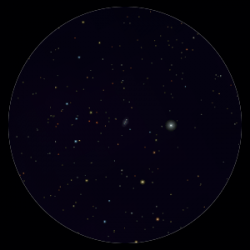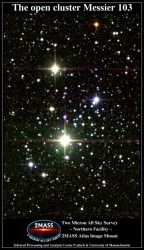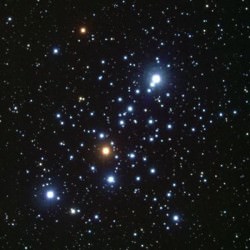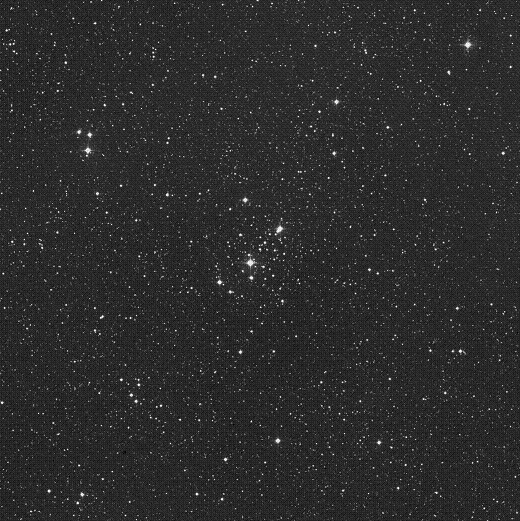Object Name: Messier 103
Alternative Designations: M103, NGC 581
Object Type: Type D Open Cluster
Constellation: Cassiopeia
Right Ascension: 01 : 33.2 (h:m)
Declination: +60 : 42 (deg:m)
Distance: 8.5 (kly)
Visual Brightness: 7.4 (mag)
Apparent Dimension: 6.0 (arc min)
Locating Messier 103: Locating M103 is fairly easy even under moderately light polluted conditions. Simply identify Delta Cassiopeiae (Ruchbah), a bright, blue-white star that marks one of the lower positions of Cassiopeia’s class “W” asterism. Simply center it in the finderscope and look about 1/2 a degree north and 1 degree east in the direction of Epsilon. In binoculars and a finderscope it will appear as a diamond shape patch of nebulosity which tries to resolve and will reveal its individual stars to even a small telescope. Loosely constructed, M103 makes a wonderful target for urban skies and less than perfect sky conditions.
 What You Are Looking At: Located some 8,500 light years away and spanning over an area about 15 light years wide, this 25 million year old star cluster can sometimes be a little hard to pick out of the surrounding star field because of its wide open profile. Notable non-member binary Struve 131 dominates the scene, and only through radial velocity studies has genuine cluster members been identified. “The cluster has been assigned a class III2p by Ruprecht {1966). Oja (1966) determined the membership of the stars for the cluster on the basis of a proper motion study and reported 73 stars to be its possible members. Out of these, UBV photoelectric magnitudes and colors are presently known for only twenty stars.” says Ram Saga arid U.C. Joshi.
What You Are Looking At: Located some 8,500 light years away and spanning over an area about 15 light years wide, this 25 million year old star cluster can sometimes be a little hard to pick out of the surrounding star field because of its wide open profile. Notable non-member binary Struve 131 dominates the scene, and only through radial velocity studies has genuine cluster members been identified. “The cluster has been assigned a class III2p by Ruprecht {1966). Oja (1966) determined the membership of the stars for the cluster on the basis of a proper motion study and reported 73 stars to be its possible members. Out of these, UBV photoelectric magnitudes and colors are presently known for only twenty stars.” says Ram Saga arid U.C. Joshi.
 But look for M103’s prominent red giant! Is there a special reason? Yes. “A statistical research on evolved stars beyond hydrogen exhaustion is performed by comparing the H-R diagrams of about 60 open clusters with a set of isochronous curves without mass loss derived from Iben’s evolutionary tracks and time scales for Population I stars.” says G. Barbaro (et al). “Although evidence concerning mass loss from stars of different types and especially red giants and supergiants is gradually increasing, still not much is known about the real causes and the quantitative aspects of this phenomena, so that up to know little can be foretold concerning its bearing on stellar evolution.”
But look for M103’s prominent red giant! Is there a special reason? Yes. “A statistical research on evolved stars beyond hydrogen exhaustion is performed by comparing the H-R diagrams of about 60 open clusters with a set of isochronous curves without mass loss derived from Iben’s evolutionary tracks and time scales for Population I stars.” says G. Barbaro (et al). “Although evidence concerning mass loss from stars of different types and especially red giants and supergiants is gradually increasing, still not much is known about the real causes and the quantitative aspects of this phenomena, so that up to know little can be foretold concerning its bearing on stellar evolution.”
History: This sparkling open cluster was discovered by Pierre Mechain in either March or April of 1781and added by Charles Messier to his catalog before he had a chance to observe it. From Mechain’s notes: “Cluster of stars between Epsilon and Delta of the leg of Cassiopeia.”
Sir William Herschel would capture it again on August 8, 1783 when he describes: “14 or 16 pL. [pretty large (bright)] stars with a great many eS. [extremely small (faint)] ones. Two of the large [bright] ones are double, one of the 1st the other of the 2nd class. (*) The compound eye glass shews a few more that may be taken into the cluster so as to make them about 20. I exclude a good many straggling ones, otherwise there would be no knowing where to stop.”
 But observing M103, didn’t stop and it would be Admiral Smyth who would be the first to see red. “”A neat double star in a cluster, on Cassiopeia’s knee, about a degree to nf of Delta. A 7 [th mag], straw coloured; B 9, dusky blue. This is a fan-shaped group, diverging from a sharp star in the nf quadrant. The cluster is brilliant from the splash of a score of its largest members, the four principle ones of which are from the 7th to the 9th magnitude; and under the largest, in the sf, is a red star of the 8th magnitude, which must be that mentioned by JH [John Herschel], No. 126 of his Catalogue of 1833. My attention was first drawn to this object, by seeing it among Srtuve’s acervi (double stars); but soon found that it was also the 103 which Messier describes so vaguely, as being between Delta and Epsilon Cassiopeiae, whereas it is pretty close to Delta, on the Lady’s knee.”
But observing M103, didn’t stop and it would be Admiral Smyth who would be the first to see red. “”A neat double star in a cluster, on Cassiopeia’s knee, about a degree to nf of Delta. A 7 [th mag], straw coloured; B 9, dusky blue. This is a fan-shaped group, diverging from a sharp star in the nf quadrant. The cluster is brilliant from the splash of a score of its largest members, the four principle ones of which are from the 7th to the 9th magnitude; and under the largest, in the sf, is a red star of the 8th magnitude, which must be that mentioned by JH [John Herschel], No. 126 of his Catalogue of 1833. My attention was first drawn to this object, by seeing it among Srtuve’s acervi (double stars); but soon found that it was also the 103 which Messier describes so vaguely, as being between Delta and Epsilon Cassiopeiae, whereas it is pretty close to Delta, on the Lady’s knee.”
Look for the colors and enjoy your observations!
Top M103 image credit, Palomar Observatory courtesy of Caltech, M103 – Roberto Mura – Wikipedia Image, M103 2MASS image and M103 image courtesy of NOAO/AURA/NSF.


